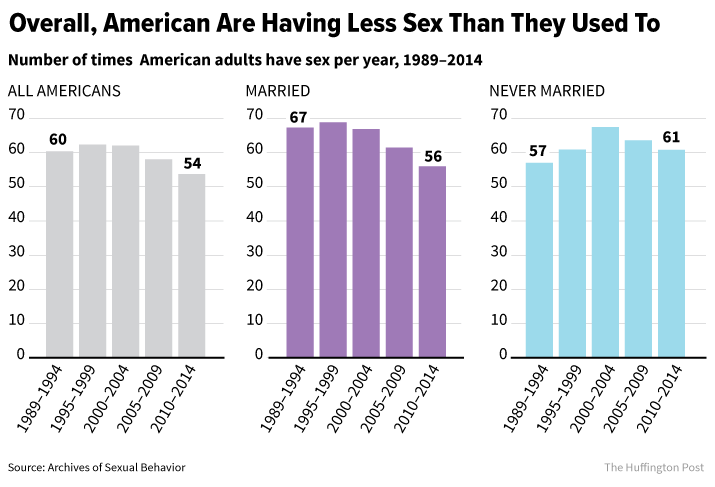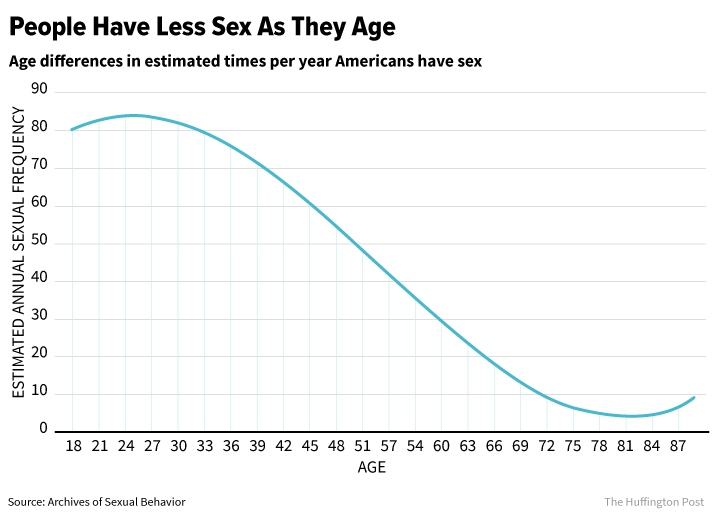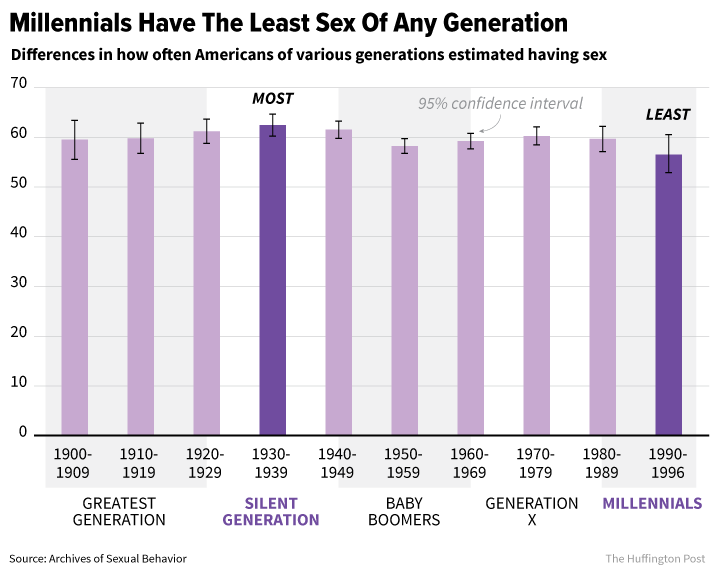American adults of every age group are having less sex than they were a generation ago, suggests a study published Tuesday in the Archives of Sexual Behavior.
Specifically, Americans born in the 1980s and 1990s are having less sex than those born in the 1960s and 1970s had at the same age ― despite their reputation for relying on dating apps to set up sexual encounters and preferring hookup culture to traditional courtship.
The study, which included data from 26,000 adults, compared sexual activity among Americans in the late 1990s to the early 2010s. It found that adults had sex an average nine fewer times per year in the early 2010s than in the early 2000s.
The decline in sex was even steeper for Americans who were married or living together. Co-habitating adults had sex an average 16 fewer times per year in the early 2010s than in the early 2000s.
“We ended up identifying two major reasons for the decline,” said study author Jean Twenge, a psychology professor at San Diego State University and author of the book Generation Me. “Fewer people have steady partners [and] the people who do have steady partners are having sex less often.”


This matters, partly because Americans’ sexual habits can lend insight into how happy or satisfied they are with their lives in a more general sense. (The sexual sweet spot for maximum happiness: Sex once per week for people who are married or in relationships.) And happy marriages come with health perks, including the so-called “marriage advantage” of having a decreased risk for heart attacks and cancer.
Here are three hypotheses for what might be causing the drop off in sexual frequency among Americans:
1. Something’s up with millennials
Millennials aren’t just having less sex. They’re also marrying later. The average age for a first marriage was 27 for women and 29 for men in 2011, according to Pew. Statistically speaking, that’s an ideal age because couples who marry in their early 20s have a higher divorce risk than slightly older couples. (Still, the window is narrow, since the divorce rate starts to creep up again for couples in their mid-30s.)
In fact, 15 percent of 20- to 24-year-olds hadn’t had any sexual partners since they were 18, compared with 6 percent of those born in the 1960s, according to a different study Twenge published last year in Archives of Sexual Behavior.
Indeed, the number of 18- to 29-year-olds who are living with a partner has remained steady over the past decade, while the number of 18- to 29-year-olds who were married fell from 29 percent in 2004 to 16 percent in 2014, according to Gallup. The bottom line: Fewer young adults are in committed relationships, which could be contributing to the decline in sex frequency for that age cohort.
Since 1989, researchers have collected data on sexual habits via the General Social Survey (Twenge used this database for her new study). This has included the question: ‘‘About how often did you have sex during the last 12 months?” Because the survey does not define what “having sex” is, it’s left up to the interpretation of the respondent, meaning different generations could define sexual activity differently (oral sex vs. penile-vaginal intercourse, for example). Twenge said she doesn’t think people included masturbation in their responses.
Twenge used a statistical analysis that took age and time period into account:

Because the sexual frequency data was self-reported, there’s also the possibility that respondents could misremember, overestimate or underestimate their sexual activity. But researchers think that respondents’ miscalculations tend to balance each other out.
Another possible limitation: Modern Americans might be more forthcoming about their sexual activity.
“If you’re going to make any argument for how the bias in response would change over time, I would expect it be people being more open to say they had more sex,” Twenge said. “If that’s the case, this decline is actually bigger than what we found.”
2. The Great Recession may be partly to blame
There’s some evidence to suggest that sex frequency can be a be a proxy for happiness, meaning it’s a trend public health and policy experts should consider examining.
Sexual frequency among married and unmarried adults plummeted around 2008, indicating the people could change their sex lives depending on the current events of the time.
“You could say, maybe that’s the Great Recession, but it doesn’t come back up,” Twenge said. “If it was just the Recession, it would come back up.”
Still, Americans haven’t uniformly experienced recovery since the recession has ended, and not everyone has recovered psychologically and emotionally from the 2008 fallout.
“We have a time when people in theory should be happy and satisfied with their lives, based on some social indicators,” Twenge said. “The unemployment rate is very low. The crime rate is very low. Those are two things that tend to covary a lot with people’s happiness.”
Of course, if the current political climate is any indication, low crime and unemployment rates don’t necessarily lead to a happy populace.
“People don’t feel comfortable committing to someone during hardships.”
- Eric Klinenberg
There’s also the possibility that a hangover from the Great Recession, while not directly contributing to libido, could affect sex rates by taking a toll on marriage.
“When there’s rough economic times, marriage rates go down,” Eric Klinenberg, co-author of Aziz Ansari’s book Modern Romance: An Investigation, told The Washington Post. “People don’t feel comfortable committing to someone during hardships.”
3. Your smartphone probably isn’t helping your sex life
Another change since 2008 is the ubiquitous presence of smartphones. Adults ages 19 to 31 who frequently used social media were more likely to feel socially isolated than their peers who used social media less often, according to a study published this month in the American Journal of Preventive Medicine.
“If you think about the way people spend their time, that’s what had the biggest effect on people’s lives,” Twenge said. “Smartphones. Social media. All of those things.”
Nearly 20 percent of young adult smartphone users between the ages of 18 and 34, and about 10 percent of older adults, reported using their smartphones during sex, according to a 2013 Harris Interactive poll on behalf of the startup Jumio. The same poll found that 12 percent of people thought their smartphone got in the way of their relationship.
